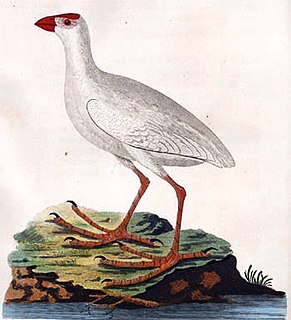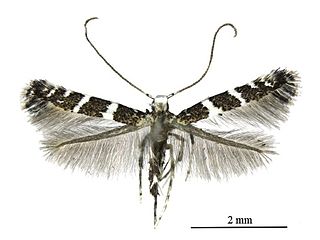
Lord Howe Island is an irregularly crescent-shaped volcanic remnant in the Tasman Sea between Australia and New Zealand, 600 km (320 nmi) directly east of mainland Port Macquarie, 780 km (420 nmi) northeast of Sydney, and about 900 km (490 nmi) southwest of Norfolk Island. It is about 10 km (6.2 mi) long and between 0.3 and 2.0 km wide with an area of 14.55 km2, though just 3.98 km2 of that comprise the low-lying developed part of the island.

The Lord Howe swamphen, also known as the Lord Howe gallinule, white swamphen, or white gallinule, is an extinct species of rail which lived on Lord Howe Island, east of Australia. It was first encountered when the crews of British ships visited the island between 1788 and 1790, and all contemporary accounts and illustrations were produced during this time. Today, two specimens exist: the holotype in the Natural History Museum of Vienna, and another in Liverpool's World Museum. Although historical confusion has existed about the provenance of the specimens and the classification and anatomy of the bird, it is now thought to have been a distinct species endemic to Lord Howe Island and most similar to the Australasian swamphen.

Gracillariidae is an important family of insects in the order Lepidoptera and the principal family of leaf miners that includes several economic, horticultural or recently invasive pest species such as the horse-chestnut leaf miner, Cameraria ohridella.

Batrachedra is the largest genus in the moth family Batrachedridae, with representatives all over the world. The early stages of most species are unknown. The genus name is derived from the Greek words batrachos, 'frog', and edra, 'seat', referring to the frog-like resting posture of the adult moths. As of 2018 at least some 114 species are known to belong to the genus.

The Lord Howe parakeet, also known as the Lord Howe red-fronted parakeet, is an extinct parrot endemic to Lord Howe Island in the Tasman Sea, part of New South Wales, Australia. It was described as full species by Tommaso Salvadori in 1891, but subsequently it has been regarded as subspecies of the red-crowned parakeet. In 2012, the IOC World Bird List recognised it as species.

Telamoptilia is a genus of moths in the family Gracillariidae.

Acrocercops is a genus of moths in the family Gracillariidae.
Acrocercops loxias is a moth of the family Gracillariidae. It is known from India (Rajasthan) and Madagascar.
Acrocercops albidorsella is a moth of the family Gracillariidae, known from Guadalcanal Island and Rennell Island, in the Solomon Islands. It was described by J.D. Bradley in 1957.
Acrocercops apicella is a moth of the family Gracillariidae, known from Guadalcanal and Rennell Island of the Solomon Islands. It was named by J.D. Bradley in 1957.
Acrocercops demotes is a moth of the family Gracillariidae, known from Mexico. It was described by Walsingham, Lord Thomas de Grey, in 1914.
Acrocercops gemmans is a moth of the family Gracillariidae, known from Mexico. It was described by Walsingham, Lord Thomas de Grey, in 1914.
Acrocercops patellata is a moth of the family Gracillariidae, known from Fiji. It was described by Edward Meyrick in 1921.
Acrocercops malvacea is a moth of the family Gracillariidae, known from Morocco. It was described by Walsingham, Lord Thomas de Grey, in 1907. The hostplant for the species is Lavatera olbia and Malva species.
Acrocercops ornata is a moth of the family Gracillariidae, known from Grenada. It was described by Walsingham, Lord Thomas de Grey, in 1897.
Acrocercops marmaritis is a moth of the family Gracillariidae, known from Mexico. It was described by Edward Meyrick in 1914.

Gracillariinae are a subfamily of moths which was described by Henry Tibbats Stainton in 1854.
Carposina euphanes is a moth in the Carposinidae family. It was described by John David Bradley in 1956. It is found on Lord Howe Island in the Tasman Sea.
Agonopterix goughi is a moth in the family Depressariidae. It was described by John David Bradley in 1958. It is found in South Africa and Saint Helena.

Acrocercopinae is a subfamily of moths described by Akito Yuji Kawahara and Issei Ohshima in 2016.








